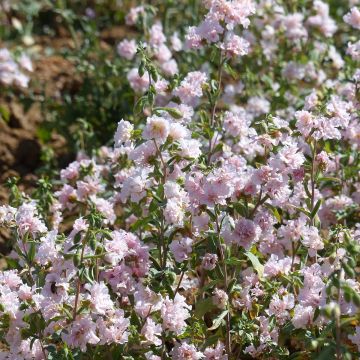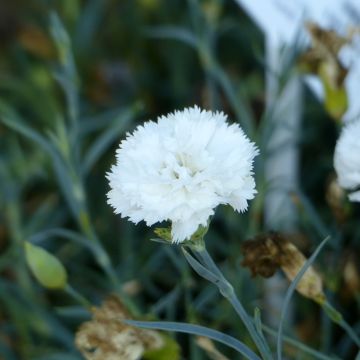

Zinnia Forecast Mix - seeds
Zinnia Forecast Mix - seeds
Zinnia (x) elegans Forecast Mix
This item cannot be shipped to the selected country
Dispatch by letter from €3.90
More information
Schedule delivery date,
and select date in basket
This plant carries a 6 months recovery warranty
More information
We guarantee the quality of our plants for a full growing cycle, and will replace at our expense any plant that fails to recover under normal climatic and planting conditions.
Seed-only orders are dispatched by sealed envelope. The delivery charge for seed-only orders is €3.90.
Does this plant fit my garden?
Set up your Plantfit profile →
Description
Zinnia 'Forecast Mix' is a very prolific variety with an attractive mix of colours. Its single or double flowers come in shades of purple, pink, orange, salmon, yellow, mauve, and cream. The petals surround a deep red centre surrounded by bright yellow stamens. This durable and easy-to-grow, very bright annual grows quickly and flowers for a long time from summer to early autumn. It can be planted with other equally undemanding flowering plants, in borders, and flower beds and then used for cutting.
Zinnia elegans is a robust annual belonging to the Asteraceae family, native to Mexico, and has given rise to numerous cultivars. 'Forecast Mix' forms an upright and branched clump, reaching an average width of 30 cm (12in) and a height of 80 cm (32in). Its stems are hollow and relatively brittle, covered with rough and downy lanceolate to elliptical, medium-green leaves. Flowering occurs from June-July to September-October, and it is nectar-rich. The flowers appear in the axils of the leaves, forming beautiful 7 cm (3in) wide heads with thin, overlapping ligules surrounding a rounded red centre from which golden yellow stamens emerge. Many seeds follow the flowers and spontaneously reseed in light soils.
Zinnias are appreciated for their ease of cultivation, and rightly so. They also show great resilience in conditions where other plants struggle. Zinnias thrive in the sun and withstand high temperatures, as long as they are given some water. They do best in neutral, rich, well-drained soil, but can also tolerate ordinary garden soil. Plant them in ornamental gardens, borders, or flower beds, and the vegetable garden. Combine zinnias with informal, naturally charming plants such as sages, perennial geraniums and coreopsis. Clumps of ornamental grasses with their spikes mingling with zinnia flowers create a beautiful display. They can also be sown in pots to decorate the terrace in summer. This nectar-rich plant will delight bees and butterflies.
Report an error about the product description
Flowering
Foliage
Plant habit
Botanical data
Zinnia
(x) elegans
Forecast Mix
Asteraceae
Cultivar or hybrid
Other Zinnia seeds
Planting and care
Sow Zinnia Forecast Mix seeds directly, from April to May, in loose and warmed soil. Do not bury the seeds too deep (3 mm (0in) is sufficient) and space them 30 cm (12in) apart. Keep the soil moist until germination, which usually takes between 7 and 14 days.
For early flowering, you can sow from March to April (indoors, at a temperature ranging from 15 to 25°C (59 to 77°F)) in a tray filled with good seed compost, which should be kept moist but not waterlogged. When the plants are large enough to handle, transplant them into pots. Gradually acclimatise your Zinnias to cooler conditions for about fifteen days before planting them in the garden, once all risk of frost has passed. Space the plants 30 cm (12in) apart.
Zinnias thrive in the sun and withstand high temperatures, as long as they are watered regularly. They perform best in neutral, rich, well-drained soil but are undemanding and can tolerate average garden soil. They may occasionally be susceptible to powdery mildew, which can be easily prevented by avoiding confined spaces and keeping their foliage dry. Be careful when planting, as slugs have a taste for their young tender leaves.
Sowing period
Intended location
This item has not been reviewed yet - be the first to leave a review about it.
Flower seeds
Haven't found what you were looking for?
Hardiness is the lowest winter temperature a plant can endure without suffering serious damage or even dying. However, hardiness is affected by location (a sheltered area, such as a patio), protection (winter cover) and soil type (hardiness is improved by well-drained soil).

Photo Sharing Terms & Conditions
In order to encourage gardeners to interact and share their experiences, Promesse de fleurs offers various media enabling content to be uploaded onto its Site - in particular via the ‘Photo sharing’ module.
The User agrees to refrain from:
- Posting any content that is illegal, prejudicial, insulting, racist, inciteful to hatred, revisionist, contrary to public decency, that infringes on privacy or on the privacy rights of third parties, in particular the publicity rights of persons and goods, intellectual property rights, or the right to privacy.
- Submitting content on behalf of a third party;
- Impersonate the identity of a third party and/or publish any personal information about a third party;
In general, the User undertakes to refrain from any unethical behaviour.
All Content (in particular text, comments, files, images, photos, videos, creative works, etc.), which may be subject to property or intellectual property rights, image or other private rights, shall remain the property of the User, subject to the limited rights granted by the terms of the licence granted by Promesse de fleurs as stated below. Users are at liberty to publish or not to publish such Content on the Site, notably via the ‘Photo Sharing’ facility, and accept that this Content shall be made public and freely accessible, notably on the Internet.
Users further acknowledge, undertake to have ,and guarantee that they hold all necessary rights and permissions to publish such material on the Site, in particular with regard to the legislation in force pertaining to any privacy, property, intellectual property, image, or contractual rights, or rights of any other nature. By publishing such Content on the Site, Users acknowledge accepting full liability as publishers of the Content within the meaning of the law, and grant Promesse de fleurs, free of charge, an inclusive, worldwide licence for the said Content for the entire duration of its publication, including all reproduction, representation, up/downloading, displaying, performing, transmission, and storage rights.
Users also grant permission for their name to be linked to the Content and accept that this link may not always be made available.
By engaging in posting material, Users consent to their Content becoming automatically accessible on the Internet, in particular on other sites and/or blogs and/or web pages of the Promesse de fleurs site, including in particular social pages and the Promesse de fleurs catalogue.
Users may secure the removal of entrusted content free of charge by issuing a simple request via our contact form.
The flowering period indicated on our website applies to countries and regions located in USDA zone 8 (France, the United Kingdom, Ireland, the Netherlands, etc.)
It will vary according to where you live:
- In zones 9 to 10 (Italy, Spain, Greece, etc.), flowering will occur about 2 to 4 weeks earlier.
- In zones 6 to 7 (Germany, Poland, Slovenia, and lower mountainous regions), flowering will be delayed by 2 to 3 weeks.
- In zone 5 (Central Europe, Scandinavia), blooming will be delayed by 3 to 5 weeks.
In temperate climates, pruning of spring-flowering shrubs (forsythia, spireas, etc.) should be done just after flowering.
Pruning of summer-flowering shrubs (Indian Lilac, Perovskia, etc.) can be done in winter or spring.
In cold regions as well as with frost-sensitive plants, avoid pruning too early when severe frosts may still occur.
The planting period indicated on our website applies to countries and regions located in USDA zone 8 (France, United Kingdom, Ireland, Netherlands).
It will vary according to where you live:
- In Mediterranean zones (Marseille, Madrid, Milan, etc.), autumn and winter are the best planting periods.
- In continental zones (Strasbourg, Munich, Vienna, etc.), delay planting by 2 to 3 weeks in spring and bring it forward by 2 to 4 weeks in autumn.
- In mountainous regions (the Alps, Pyrenees, Carpathians, etc.), it is best to plant in late spring (May-June) or late summer (August-September).
The harvesting period indicated on our website applies to countries and regions in USDA zone 8 (France, England, Ireland, the Netherlands).
In colder areas (Scandinavia, Poland, Austria...) fruit and vegetable harvests are likely to be delayed by 3-4 weeks.
In warmer areas (Italy, Spain, Greece, etc.), harvesting will probably take place earlier, depending on weather conditions.
The sowing periods indicated on our website apply to countries and regions within USDA Zone 8 (France, UK, Ireland, Netherlands).
In colder areas (Scandinavia, Poland, Austria...), delay any outdoor sowing by 3-4 weeks, or sow under glass.
In warmer climes (Italy, Spain, Greece, etc.), bring outdoor sowing forward by a few weeks.
























































